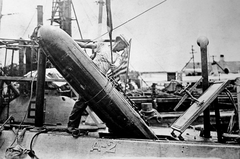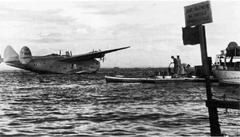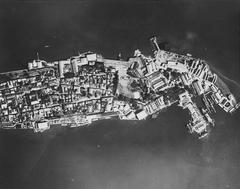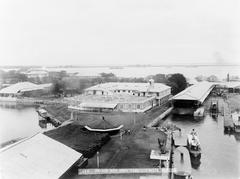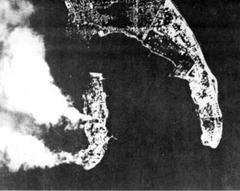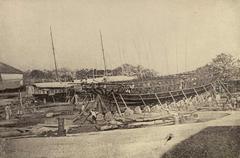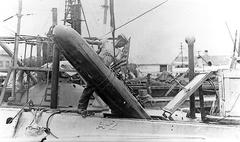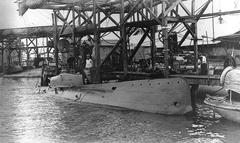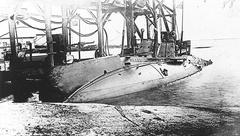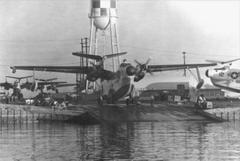
Pascual Ledesma Naval Station: Visiting Hours, Tickets, and Travel Guide for Cavite City’s Premier Historical Site
Date: 15/06/2025
Introduction
Naval Station Pascual Ledesma, located at Cavite Point in Cavite City, Philippines, stands as a testament to the nation’s rich maritime heritage and evolving naval defense capabilities. Established during the Spanish colonial era as the Cavite Navy Yard and anchored by the storied Fort San Felipe, this site has played a central role in key chapters of Philippine history—from the Manila Galleon trade and the 1872 Cavite Mutiny to American modernization, the devastation of World War II, and the assertion of Philippine sovereignty. Today, it continues as an operational hub for the Philippine Navy while welcoming history enthusiasts through guided tours by special appointment (dbpedia.org, Philippine Navy Official Website, mapcarta.com).
This comprehensive guide will provide you with essential information on visiting hours, ticketing, access procedures, travel tips, and the region’s historical and architectural treasures. Whether you are a student of history, a military buff, or a traveler seeking to understand the Philippines’ naval past, Naval Station Pascual Ledesma is an unmissable destination.
Table of Contents
- Early Foundations and Spanish Colonial Era
- American Occupation and World War II
- Postwar Reconstruction and Philippine Sovereignty
- Legacy of Commodore Pascual Ledesma
- The Base’s Role in Modern Naval Operations
- Visiting Hours, Tickets, and Access
- Special Events and Photographic Spots
- Nearby Attractions and Travel Tips
- Architectural and Cultural Heritage
- Historical Significance in National Identity
- Frequently Asked Questions (FAQ)
- Plan Your Visit: Next Steps
1. Early Foundations and Spanish Colonial Era
Naval Station Pascual Ledesma’s origins trace back to the Spanish colonial period, when Cavite Point’s strategic position on Manila Bay made it a linchpin of maritime defense and shipbuilding. The Spanish constructed Fort San Felipe in the 17th century as a bastion against foreign threats and piracy, and the adjacent Cavite Navy Yard soon became the epicenter of ship repair and construction for the famed Manila Galleons that sailed between Manila and Acapulco (dbpedia.org).
Through the 18th and 19th centuries, the naval yard expanded with dry docks, armories, and support facilities. The area bore witness to landmark events such as the 1872 Cavite Mutiny, where Filipino workers and soldiers rose against Spanish authorities—an episode that fueled the Filipino nationalist movement. The fort thus became not just a military asset, but a symbol of resistance and the birth of Filipino identity.
2. American Occupation and World War II
After the Spanish-American War in 1898, the United States assumed control of the Cavite Navy Yard, modernizing it to support the U.S. Asiatic Fleet. The base became a key site for ship repair, logistics, and naval operations in the Asia-Pacific.
World War II brought the Cavite Navy Yard into sharp focus. On December 10, 1941, Japanese bombers inflicted devastating damage on the installation, significantly hampering Allied naval capabilities in the Philippines. Despite the destruction, Filipino and American forces continued to resist until the eventual fall of Bataan and Corregidor (dbpedia.org).
3. Postwar Reconstruction and Philippine Sovereignty
Following liberation in 1945, the United States Navy restored and upgraded the base, recognizing its strategic significance. The growing movement for Philippine independence led to a gradual transfer of control, culminating in its official designation as a Philippine Navy Operating Base by the early 1950s. The consolidation of naval operations in Cavite was further reinforced by the transfer of Sangley Point in 1971, strengthening national sovereignty (dbpedia.org).
4. Legacy of Commodore Pascual Ledesma
Renamed in 2009, the base honors Commodore Pascual Ledesma (1843–1917), a key figure in the Philippine Revolution and recognized as the first Officer-In-Command of the Philippine Navy. His leadership and vision reflect the resilience and patriotism that the base embodies (dbpedia.org).
5. The Base’s Role in Modern Naval Operations
Today, Naval Station Pascual Ledesma occupies a 9-hectare site at Cavite Point’s tip in San Roque, centered on Fort San Felipe. It serves as a vital Philippine Navy hub for operations, logistics, and administration, supporting modernization efforts such as the construction and maintenance of Acero-class patrol gunboats (mapcarta.com). The base is also integral to training, disaster response, and regional maritime security initiatives.
6. Visiting Hours, Tickets, and Access
Public Access:
Naval Station Pascual Ledesma is an active military facility. Public visits are strictly by appointment and must be coordinated in advance through the Philippine Navy’s Public Affairs Office. Walk-ins are not permitted.
Visiting Hours:
Guided tours are typically available Monday to Friday, 8:00 AM – 4:00 PM, excluding public holidays and military events.
Tickets/Fees:
There is currently no admission fee for guided tours, but all visitors must present valid identification and comply with security protocols.
How to Arrange a Visit:
- Contact the Philippine Navy Public Affairs Office or the Cavite City tourism office.
- Submit a letter of request, attendee list, and valid IDs.
- Arrange your tour at least one week in advance; school and group tours should plan several weeks ahead.
- Special events (e.g., Independence Day, Philippine Navy anniversaries) may provide additional public access opportunities.
Accessibility:
Key areas, including Fort San Felipe grounds and main exhibits, are wheelchair accessible. Some historic structures may have limited access due to preservation.
Parking:
Limited parking is available; public transportation and taxis are recommended.
Photography:
Permitted only in designated areas and with prior approval.
Dress Code:
Modest attire is required—long pants, closed shoes, and shirts with sleeves.
7. Special Events and Photographic Spots
The naval station hosts commemorative events, including Philippine Navy anniversaries and historical reenactments. These occasions offer unique opportunities for immersive experiences and photography.
Top Photo Locations:
- Fort San Felipe’s stone bastions and cannons
- Panoramic views over Manila Bay
- Preserved historic dockyards
Best lighting is in the early morning and late afternoon.
8. Nearby Attractions and Travel Tips
Nearby Cavite City Historical Sites:
- Kawit: Site of the Philippine Declaration of Independence
- Bacoor and Imus: Revolutionary towns rich in heritage
- Samonte Park: Adjacent green space for relaxation
- Museo ng Paglilitis ni Andres Bonifacio: Museum on the trial of the revolutionary leader
Travel Tips:
- Use public transport or ride-sharing apps to avoid parking issues.
- Carry valid ID and dress respectfully.
- Check the weather before your visit.
- Contact the base in advance if you have mobility needs.
9. Architectural and Cultural Heritage
Naval Station Pascual Ledesma is not only a military base but a living museum of Philippine naval evolution. Fort San Felipe, with its moss-covered granite walls, antique cannons, and mini-museum, preserves centuries of naval history. Remnants of old barracks, armories, and dry docks showcase the development of maritime defense technologies (mapcarta.com, Mapcarta - Fort San Felipe).
The base’s proximity to Cavite’s revolutionary towns and cultural sites provides a holistic historical experience.
10. Historical Significance in National Identity
Naval Station Pascual Ledesma has been a silent witness to the Philippines’ journey from colonial outpost to sovereign nation. The base’s association with events like the Cavite Mutiny and the Philippine Revolution, and its namesake’s revolutionary legacy, imbue it with deep national significance.
Touring the station offers visitors tangible engagement with the narratives of resistance, independence, and nation-building that have shaped the Philippines.
11. Frequently Asked Questions (FAQ)
Q: Can civilians visit Naval Station Pascual Ledesma?
A: Yes, but only by prior arrangement with the Philippine Navy. No walk-ins allowed.
Q: Are tickets required?
A: No ticket fees are currently charged for official tours.
Q: What are the best times to visit?
A: Weekdays in the morning provide the best experience and lighting.
Q: Are guided tours available?
A: Yes, but must be booked in advance through official channels.
Q: What nearby attractions can I visit?
A: Fort San Felipe, Kawit, Bacoor, Imus, Samonte Park, and local museums.
Q: Is the base accessible for people with disabilities?
A: Main areas are accessible, but some historic structures may have limitations. Notify the base in advance for assistance.
12. Plan Your Visit: Next Steps
Naval Station Pascual Ledesma offers a unique perspective on Philippine maritime history, military tradition, and national identity. With careful planning and advance coordination, visitors can experience its storied past and vibrant present.
- For real-time updates, guided tour bookings, and interactive maps, download the Audiala app.
- Follow us on social media for exclusive content and travel tips.
Key Takeaways
Naval Station Pascual Ledesma stands as a cornerstone of Philippine naval heritage, bridging centuries of colonial, revolutionary, and modern military history. While public access is limited due to its active military status, guided tours provide a rich educational and cultural experience. The base’s preserved architecture, commemorative events, and proximity to revolutionary towns make it a must-visit for those seeking to understand the Philippines’ maritime evolution and patriotic spirit.
Plan your visit well in advance, adhere to security protocols, and use digital tools like the Audiala app to maximize your experience. Naval Station Pascual Ledesma is not just a destination—it is a journey through the heart of Philippine history and identity (dbpedia.org, Philippine Navy Official Website, mapcarta.com).
References & Further Reading
- Naval Base Cavite – DBpedia
- Philippine Navy Official Website
- Naval Station Pascual Ledesma – Mapcarta
- Fort San Felipe – Mapcarta
- Naval Base Cavite – Top10Place Visitor Info
